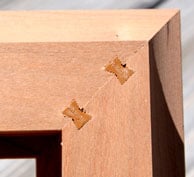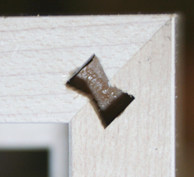Dovetail-routed Frames
Dovetail Frame Assembly
We have found the following methods effective for assembling our frames using the Hoffmann Dovetail System. We recommend you always INSPECT the frame and DRY-FIT the mitered corners face up on a level table before assembling – Do NOT install plugs at this time, as they cannot be removed.
Supplies and Tools:
- Dovetail plugs
- Wood glue. We use standard Titebond wood glue, but Corner Weld or other wood glues are fine too.
- Hammer
- Slightly damp, soft cloth – to wipe off glue squeeze out if needed
- T-shaped allen key works well to drive the dovetail plugs in. For the skinny profiles (up to 1/2″ face) we use a 2mm key. For the wider profiles, we use a 1/8″ key
For All Assembly Methods:
- For a perfectly even corner, use a flat, smooth, clean surface that does not have any “give” (not padded or carpeted.)
- Clean the surface well so there is no sawdust, dried glue, or other debris that could cause scratches or indentations in the finish.
- Before applying glue, do one more dry test of the corner while it is in the appropriate vice, jig, or on the table.
- Apply only enough glue to adhere the mitered surface. AVOID EXCESSIVE GLUE! Note: Glue squeeze out can damage the finish!
- On taller mouldings where multiple plugs are used in each channel, insert the shortest plug first, which allows you to slightly realign the face and corner if needed. It is critical to have the corner aligned perfectly before tapping in the longer plugs as the alignment cannot be adjusted once the plugs are tapped in. Tap the longer plug immediately after the shorter plug until flush with the back, or recess with allen key if desired.
- Assemble two half frame “L’s” first, let them dry, then assemble the third and fourth corners with glue. You can either put glue on both the third and fourth corner at the same time and assemble, or you can glue the third corner, allow it to dry, then use a razer blade or thin piece of cardboard to apply glue to the fourth corner.
- Lift up the assembled corner and inspect the face. If any glue did squeeze out, carefully wipe it off with a soft, slightly damp cloth.
Flat-faced and Float Frame mouldings: can be assembled face down on a flat, clean table.
- Special notes: on larger float frames like 972 and 975, always install dovetail plugs in the stem before the shelf. This helps the alignment and keeps the shelf flat. On float frames, even when the face is aligned properly, the shelf might not line up perfectly. Not much can be done to prevent this, but any offset should mostly remain hidden.
- When assembling a frame with the face down, be sure the surfaces of the table and moulding are both clean. Do NOT slide the moulding as this could scratch the surface.
- Carefully place all four legs upside down in the desired frame arrangement. Dry fit one more time before applying glue.
- Apply a small but evenly distributed amount of glue to the miter surface, enough to adhere corner without squeeze out. On float frames, apply glue to both the shelf and stem. Do NOT put glue in the channel where the dovetail goes.
- Push both sides of the corner together to close the miter, keeping it aligned. Before glue sets, carefully begin inserting a plug with gentle thumb pressure.
- Recheck alignment of the corner then tap plugs with a hammer until flush with the back of moulding. If you wish, you can drive it all the way in using an allen key to finish setting the plug. On 1/2″ or narrower mouldings, you can drive it in with a 2mm allen key, but be careful to not over-drive this narrow plug! Too much pressure can split the wood!
All other mouldings shapes:
- Place moulding in corner vice, align, and glue as you would any other assembly method.
- Let the glue dry thoroughly.
- When dry, gently remove the corner from the vice and place it on a flat, level table – face up.
- Gently slide only the corner off the table enough to expose the routed groove(s) on the underside – keep both legs of the frame firmly supported on the flat surface to avoid stressing the corner.
- Gently insert a dovetail plug into the groove and push up as far as possible with your fingers while applying counter-pressure to the face of the moulding. Careful to keep the face aligned. Note: plugs are a snug fit.
- Once the plug has been started into the groove, there are a couple of good options.
- A) lift up the corner and rest the protruding plug back on to the table. Gently and firmly push the corner downward against the table. This will force the dovetail plug deeper into the groove until it becomes flush with the back of the corner.
- or B) while the corner is still off the table, hold the handle of a hammer and use the head of the hammer or top “T” surface to gently push the plug flush to the back of the moulding. Be sure to provide counter pressure on the face to retain alignment.
- If each groove requires more than one plug, insert the smallest plug first then additional plugs as needed using the same method.
- If there is more than one routed groove per corner (as on a wider moulding) start both plugs at the same time.


